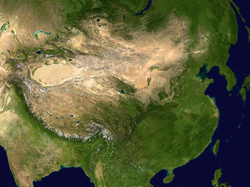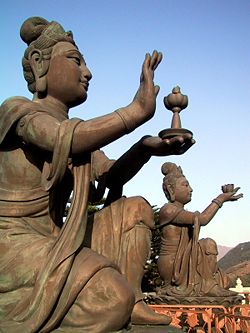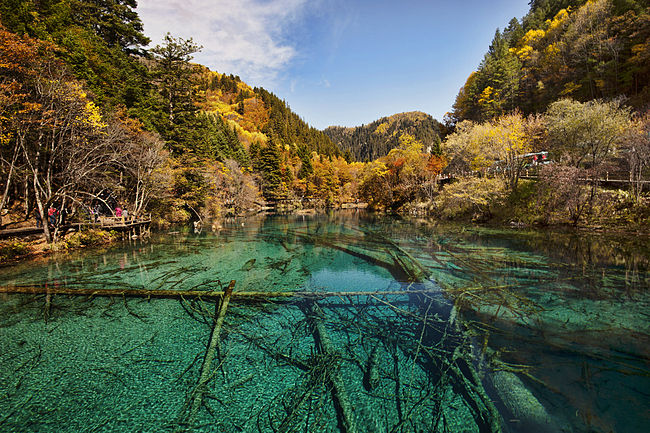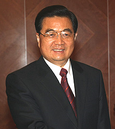- Portal:China
-
- Wikipedia portals:
- Culture
- Geography
- Health
- History
- Mathematics
- Natural sciences
- People
- Philosophy
- Religion
- Society
- Technology

China (Simplified Chinese: 中国, Traditional Chinese: 中國, literally "the Middle Kingdom") is a cultural region, a civilisation, and a country in East Asia, that is home to one-fifth of the world's population.
China is the world's oldest continuous civilization, consisting of states and cultures dating back more than 5,000 years. Its history has been largely characterized by repeated divisions and reunifications amid alternating periods of peace and war, and violent imperial dynastic change. The country's territory expanded outwards from a core area in the North China Plain, and varied according to its changing fortunes to include regions of East, Northeast, and Central Asia. For centuries, Imperial China was also one of the world's most technologically advanced civilizations, and East Asia's dominant cultural influence, with Chinese religion, customs, and writing systems being adopted to varying degrees by neighbors such as Japan, Korea and Vietnam, and having an impact lasting to the present day.
China also has the world's longest continuously used written language system, the Chinese language, and is the source of many major inventions, such as the Four Great Inventions of Ancient China: paper, the compass, gunpowder, and the printing press. Its landscape is diverse with forest steppes and deserts in the dry north near Mongolia and Russia's Siberia, and subtropical forests in the south close to Vietnam, Laos, and Burma. The terrain in the west is rugged and high altitude, with the Himalayas and the Tian Shan mountain ranges forming China's natural borders with India and Central Asia, while in contrast, China's eastern seaboard is low-lying and has a 14,500-kilometre long coastline bounded on the southeast by the South China Sea, and on the east by the East China Sea.
Since 1949, and as a result of the stalemate of the Chinese Civil War, two political entities have been using the name "China": the People's Republic of China, which is often what is meant by the term China, and the Republic of China, which is more commonly known as Taiwan.
See also:
 Portal:People's Republic of China and
Portal:People's Republic of China and  Portal:Republic of China
Portal:Republic of ChinaSelected panorama
Selected article
Chinese New Year (simplified Chinese: 春节; traditional Chinese: 春節; pinyin: Chūn jié), or Spring Festival or the Lunar New Year (simplified Chinese: 农历新年; traditional Chinese: 農曆新年; pinyin: Nóng lì xīn nián), is the most important of the traditional Chinese holidays. It is an important holiday in East Asia. The festival proper begins on the first day of the first lunar month (Chinese: 正月; pinyin: zhēng yuè) in the Chinese calendar and ends on the 15th; this day is called the Lantern Festival (simplified Chinese: 元宵节; traditional Chinese: 元宵節; pinyin: yuánxiāojié).
Chinese New Year's Eve is known as Chúxì (除夕). Chu literally means "change" and xi means "Eve".
Celebrated in areas with large populations of ethnic Chinese, Chinese New Year is considered a major holiday for the Chinese and has had a strong influence on the new year celebrations of its neighbours. These include Koreans, Mongolians, Nepalese, Bhutanese, Vietnamese, and formerly the Japanese before 1873.
In countries such as Singapore, Malaysia, The Philippines, Thailand, and other countries with significant Chinese populations, the Lunar New Year is also celebrated, largely by ethnic Chinese, but it is not part of the traditional cultures of these countries. In Thailand, for example, the true New Year celebration of the ethnic Thais is Songkran, which is totally different and is celebrated in April. (More...)
Selected biography
Hu Jintao (born December, 21 1942, in Taizhou, Jiangsu) is the current Paramount Leader of the People's Republic of China. He has held the titles of General Secretary of the Communist Party of China since 2002, President of the People's Republic of China since 2003, and Chairman of the Central Military Commission since 2004, succeeding Jiang Zemin as the top leader of fourth generation leadership of the People's Republic of China.Hu possesses a low-key and reserved leadership style. His rise to the presidency represents China's transition of leadership from old, hard-core communists to younger, more pragmatic technocrats. Since his ascendancy, Hu has reinstated certain controls on the economy relaxed by the previous administration, and has been highly conservative in his attitude to political reforms. In foreign policy, Hu advocates for an approach termed "China's peaceful development", pursuing soft power in international relations. Through Hu's tenure, China's global influence in Africa, Latin America, and other developing countries has increased.
Hu has been involved in the Communist party bureaucracy for most of his adult life, notably as party chief for the Tibet Autonomous Region, and then later Secretary of the Secretariat of CPC and Vice-President under Jiang Zemin. Hu's political philosophy is summarily described as aiming to found a basis for Harmonious Society domestically and for Peaceful Development internationally, the former generated by a Scientific Development Concept, which seeks integrated solutions to tackle China's various economic, environmental and social problems.
Did you know...
- ... China shares its borders with fourteen different countries, including Russia, India, Kazakhstan, Vietnam, North Korea and Pakistan?
- ... that China has over 1.3 billion people, with the capital (Beijing) having 19 612 368 people, while the largest city in China is Shanghai, having 23 019 148 people?
- ... the average life expectancy age of a Chinese child at birth is 74.68 years, ranking 95th compared to the rest of the world?
- ... the current chief of state is President Hu Jintao, the 6th president and paramount leader of the People's Republic of China?
- ... the head of government in China is the Premier? The current premier of China is Wen Jiabao. A premier has one executive vice premier (currently Li Keqiang) and three vice premiers (Zhang Dejiang, Hui Liangyu and Wang Qishan).
Selected picture

Buddhistic statues, praising the Tian Tan Buddha, Lantau Island, Hong Kong. Photo credit: AngMoKio
In the news
News on China at Wikinews- October 22: Chinese girl who was hit and run by two drivers, ignored by eighteen people, dies
- September 10: Out of space in outer space: Special report on NASA's 'space junk' plans
- August 17: Chinese human rights activist faces trial
- August 16: Wikinews interviews Chinese-American martial artist Alfred Hsing
- August 13: China sends its first aircraft carrier to sea
- July 24: Train accident in China kills at least 43
- July 11: China's consumer prices rise to a three-year high in June as food prices soar 14.4 percent
- July 7: Bahamas become fourth country to ban shark fishing
- July 3: Philippine Foreign Secretary Del Rosario to visit China amid South China Sea territorial dispute
- June 28: Chinese political dissident Hu Jia freed as Chinese Premier Wen visits Britain
Things you can do
 Complete list | Chinese noticeboard
Complete list | Chinese noticeboard- Wikipedia:WikiProject China/Chinese cities workgroup
- Wikipedia:WikiProject China/Chinese provinces workgroup
- Requests: Economic development in China, Lingnan architecture, Contemporary Chinese art, More...
- Expand: Cai Lun, Bashidang, Chang Dai-chien, China National Ethnic Song and Dance Ensemble, Chinese folk religion, Culture of China, Min Bei, Government Information Office, Zhao Rugua, Linfen
- Cleanup: Xinhai Revolution, Siege of Tuyen Quang, Battle of Tzeki, Politics of Manchukuo
- Copyedit: Wang Shiwei, Transfer of the sovereignty of Macau
- Images: Category:Wikipedia requested photographs in China
- Portal: Fill in Anniversaries, update Did you know?, suggest Selected articles and pictures, maintain Portal:People's Republic of China and Portal:Republic of China (shared task with WikiProject Taiwan).
- References: Add references to Unreferenced BLPs.
- Translation: Please visit the Chinese translation department and the Chinese transwiki project for more details.
- Verify: Nanjing University, Mao suit
Related portals

Politics: People's Republic of China • Republic of China
Geography: Asia • Himalaya region • Hong Kong • Macau • Taiwan • Tibet
Religion: Buddhism • Christianity in China • Confucianism • Taoism • Tibetan BuddhismRelated WikiProjects


You are invited to participate in WikiProject China, a WikiProject dedicated to developing and improving articles about China.
Main: China
Arts: Cinema • Entertainment • Go (board game) • Martial arts
Geography: Cities • Provinces • Hong Kong • Macau • Taiwan • Tibet
History: History • Military history • Three Kingdoms
Language: Chinese surnames • CJKV
Politics: Politics
Religion: Buddhism • Christianity • Taoism
Images: Cartography
Miscellaneous: Transportation • Uyghurs of Western ChinaTopics
- History of China - Timeline of Chinese history - Three Sovereigns and Five Emperors - Xia - Shang - Zhou (Spring and Autumn Period - Warring States Period) - Qin -
 Han - Xin - Three Kingdoms (Cao Wei - Shu Han - Eastern Wu) - Jin - Sixteen Kingdoms - Southern and Northern Dynasties - Sui -
Han - Xin - Three Kingdoms (Cao Wei - Shu Han - Eastern Wu) - Jin - Sixteen Kingdoms - Southern and Northern Dynasties - Sui -  Tang - Five Dynasties and Ten Kingdoms Period - Liao -
Tang - Five Dynasties and Ten Kingdoms Period - Liao -  Song - Western Xia - Jin - Yuan -
Song - Western Xia - Jin - Yuan -  Ming - Qing - History of the Republic of China - History of the People's Republic of China - Taiwan after World War II
Ming - Qing - History of the Republic of China - History of the People's Republic of China - Taiwan after World War II
- History by topic: Economic history - Military history - Naval history - History of geography in China - History of science and technology in China - History of China's administrative divisions
- Geography of China - Environment - Flora and fauna - Provinces - Counties[disambiguation needed
 ] - Cities
] - Cities
- Culture of China - Architecture - Art - Calligraphy - Cinema - Clothing - Cuisine - Law - Literature - Martial arts - Medicine - Music - Mythology - Philosophy - Religion - Social structure
- Chinese language - Chinese grammar - Classical Chinese - Written Chinese (Chinese character - Traditional Chinese characters - Simplified Chinese characters) - Spoken Chinese (Mandarin Chinese - Wu Chinese - Cantonese - Min Chinese - Xiang Chinese - Hakka - Gan) - Chinese as a second language
- Ethnic groups in China - Bai - Blang - Bonan - Buyei - Dai - Daur - De'ang - Derung - Dong - Dongxiang - Evenk - Gaoshan - Gelao - Han - Hani - Hezhen - Hui - Jing - Jingpo - Jino - Kazakh - Kirgiz - Korean - Lahu - Lhoba - Li - Lisu - Manchu - Maonan - Miao - Monba - Mongol - Mulao - Nakhi - Nu - Oroqen - Pumi - Qiang - Russian - Salar - She - Shui - Tajik - Tatar - Tibetan - Tu - Tujia - Uyghur - Uzbek - Va - Xibe - Yao - Yi - Yugur - Zhuang - Ethnic minorities - Undistinguished ethnic groups
- For topics about the two political entities that make up modern-day China, see Portal:People's Republic of China and Portal:Republic of China.
Categories
[×] China portalsWikipedias in languages found in China
粵語 / 廣東話 (Cantonese) • 古文 / 文言文 (Classical Chinese) • 贛語 (Gan) • Hak-kâ-fa (Hakka) • قازاق تىلى (Kazakh) • 中文 / 普通話 (Mandarin) • 閩東語 (Min Dong) • 閩南語 (Min-nan) • བོད་ཡིག (Tibetan) • ئۇيغۇرچە (Uyghur) • 吳語 / 吳儂軟語 (Wu) • Sawcuengh (Zhuang)
Associated Wikimedia
Categories:- China portals
- Asian portals
- China
Wikimedia Foundation. 2010.





